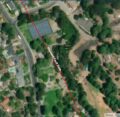El Cerrito Lore
The geography, flora, and fauna of El Cerrito and the East Bay is fascinating and here’s a big glimpse into it! Read (or maybe browse!) this 264 page, encompassing report:
Hillside Natural Fire Resilience and Forest Conservation Management Plan- El Cerrito, December 2024 Draft
Backstory: the city of El Cerrito commissioned a report on maintaining and cleaning up the Hillside Natural Area (HNA) as part of the Hillside Natural Area Plan. In it, they offer all manner of details about the area, what could be cleaned up and how it would be done.
Some parts I found interesting:
- The Quarry Hill eucalyptus grove was planted around 1910 by the quarry operator to minimize slippage of quarry overburden. The report mentions that removing those giant, highly flammable, invasive trees will be hugely expensive ($100k at least)
- The Hayward fault runs some 1,000 feet east of HNA. That puts it 500 east of my daughter’s elementary school! Apparently it runs right through one of our local parks, I’ll have to check that out!
- Geologist nerds will know what this means, I hope! “The HNA’s geology is a complex assemblage of metamorphic rock (blueschist, Tiburon melange, Angel Island nappe, and Alcatraz nappe), overlaid in areas by the Northbrae rhyolite, a lava layer.”
I often think about how native and non-native species of plants in the area and whether I could help make a native area thrive. Well, according to the report, the hillside is a crazy mix of native and non-native:
“Ruderal/Non-Native Grassland (33.47 acres, 31.2 percent of the HNA) consists primarily of nonnative annual grassland species, with patches of perennial grassland and ruderal plant species. Grassland vegetation consists primarily of introduced annuals such as wild oats (Avena spp.), soft chess (Bromus mollis), ripgut brome, (Bromus diandrus), Italian ryegrass (Lolium multiflorum), and foxtail barley (Hordeum leporinum)…”
Though the natives have a time of it, all is not lost. The native plants have found their niches.
“Native Grasslands consist of small, dispersed patches of native graminoids, including perennial bunchgrasses. These are generally rare but fairly common in certain areas, such as El Cerrito Memorial Grove and the Julian Fuel Break, which supports a healthy stand of purple needlegrass. Needlegrass grassland within the HNA is dominated by native perennial bunchgrasses such as purple needlegrass, foothill needlegrass (Stipa lepida)…”
The report covers a lot more!
